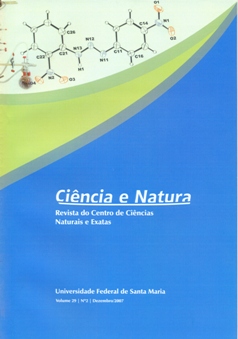Análise da Variabilidade Térmica em Zonas de Bordas Florestais com Interface Urbana no Maciço da Tijuca Rio de Janeiro-RJ
DOI:
https://doi.org/10.5902/2179460X9892Abstract
The goal of this research was to identify and assess the termic gradientgenerated by the spread of the brim effect on the city-forest interface in twoselected areas with different degrees of urban density ( Catrambi area – high174 Ciência e Natura, UFSM, 29(2): 173 - 186, 2007density, and Soberbo area – low density), on the edge of Floresta da Tijuca- Rio de Janeiro (RJ). The working hypothesis was that the increase inurban pressure on the city-forest interface zone edge about a change in thedynamics of the edge effect, accelerating its propagation, especially in regardto termic changes, with a direct impact on the system’s functionality. Fielddata gathered from three transects measuring 100 meters in each area (with5 100 m2 patches in each transect). The results of this research point outthat the difference in urban density between the two researched areas bearsa significant influence on the propagation of the edge effect (with differenceuntil 3,5°C in the transect border-center) , but not directly, since it does sothrough an increase in the density of tracks and pathways internal to theedge area.Downloads
Downloads
Published
How to Cite
Issue
Section
License
To access the DECLARATION AND TRANSFER OF COPYRIGHT AUTHOR’S DECLARATION AND COPYRIGHT LICENSE click here.
Ethical Guidelines for Journal Publication
The Ciência e Natura journal is committed to ensuring ethics in publication and quality of articles.
Conformance to standards of ethical behavior is therefore expected of all parties involved: Authors, Editors, Reviewers, and the Publisher.
In particular,
Authors: Authors should present an objective discussion of the significance of research work as well as sufficient detail and references to permit others to replicate the experiments. Fraudulent or knowingly inaccurate statements constitute unethical behavior and are unacceptable. Review Articles should also be objective, comprehensive, and accurate accounts of the state of the art. The Authors should ensure that their work is entirely original works, and if the work and/or words of others have been used, this has been appropriately acknowledged. Plagiarism in all its forms constitutes unethical publishing behavior and is unacceptable. Submitting the same manuscript to more than one journal concurrently constitutes unethical publishing behavior and is unacceptable. Authors should not submit articles describing essentially the same research to more than one journal. The corresponding Author should ensure that there is a full consensus of all Co-authors in approving the final version of the paper and its submission for publication.
Editors: Editors should evaluate manuscripts exclusively on the basis of their academic merit. An Editor must not use unpublished information in the editor's own research without the express written consent of the Author. Editors should take reasonable responsive measures when ethical complaints have been presented concerning a submitted manuscript or published paper.
Reviewers: Any manuscripts received for review must be treated as confidential documents. Privileged information or ideas obtained through peer review must be kept confidential and not used for personal advantage. Reviewers should be conducted objectively, and observations should be formulated clearly with supporting arguments, so that Authors can use them for improving the paper. Any selected Reviewer who feels unqualified to review the research reported in a manuscript or knows that its prompt review will be impossible should notify the Editor and excuse himself from the review process. Reviewers should not consider manuscripts in which they have conflicts of interest resulting from competitive, collaborative, or other relationships or connections with any of the authors, companies, or institutions connected to the papers.






